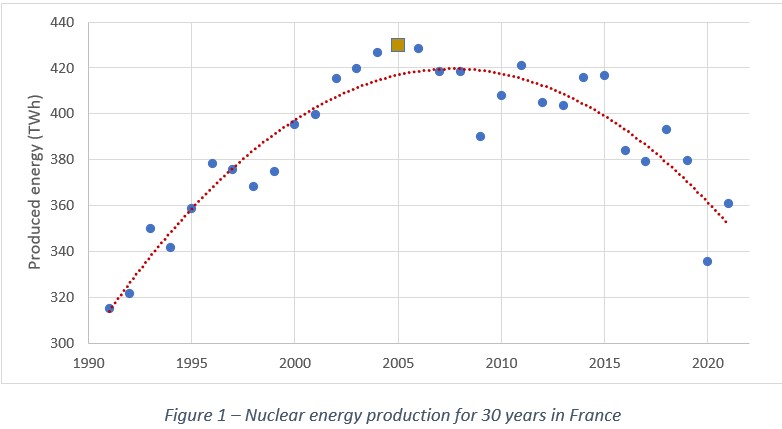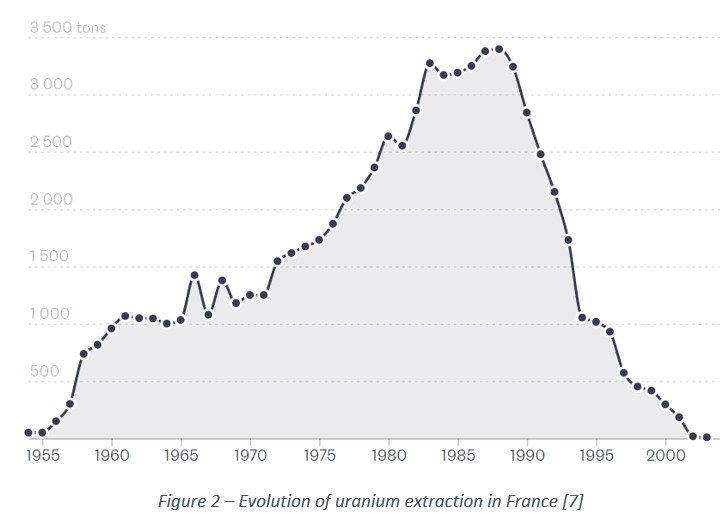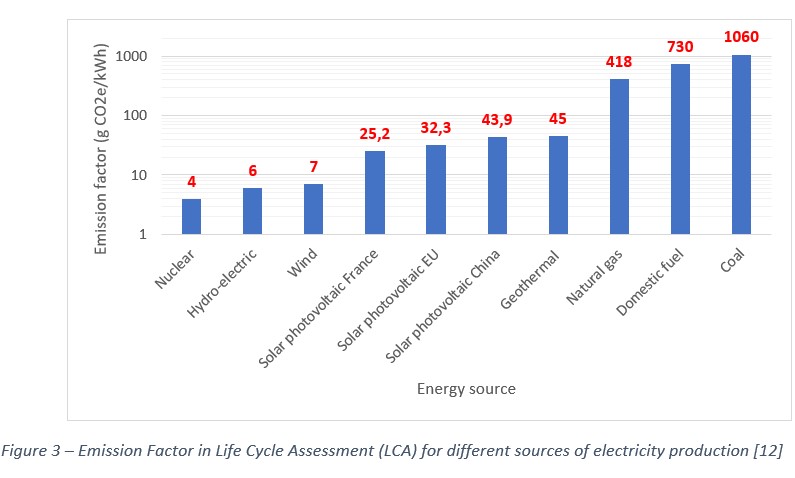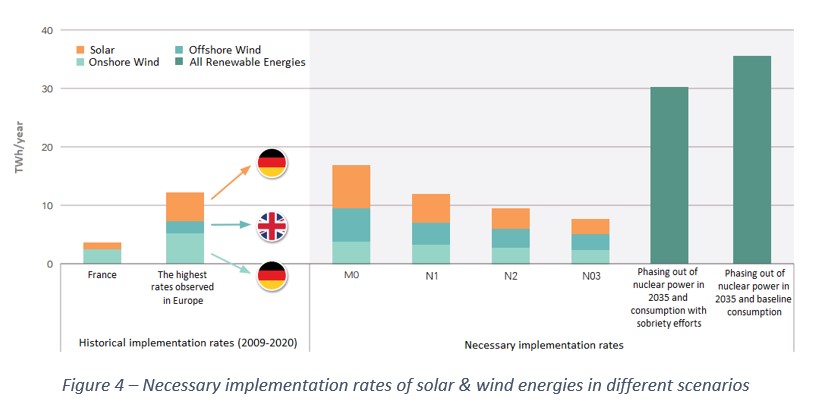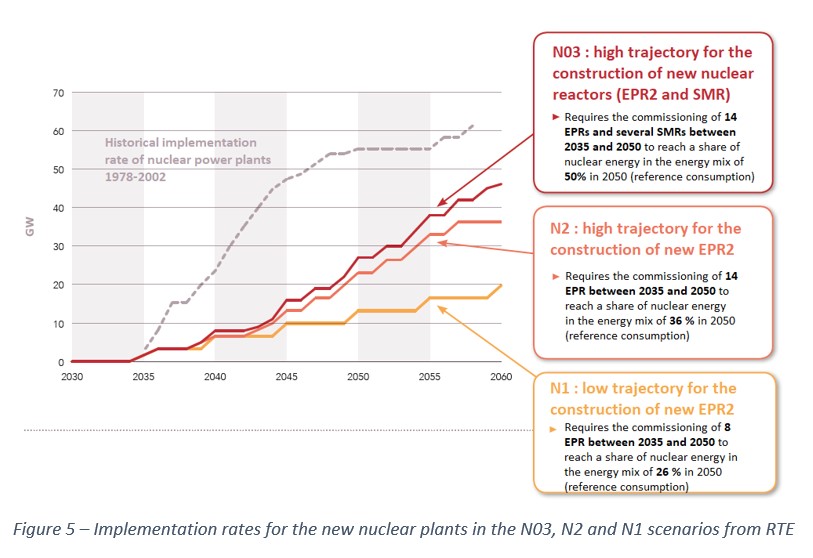French nuclear power, the great unknown in the decarbonization of the European energy sector
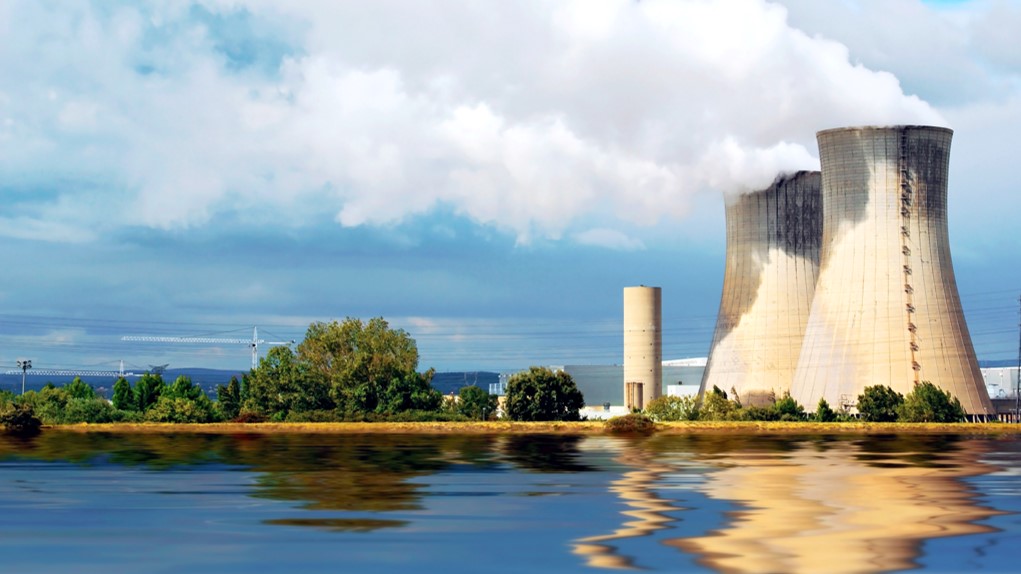
As part of its national low-carbon strategy (SNBC), France relies in part on its low-carbon electricity supplied by its nuclear reactors. But is it realistic?
By Pierre-Emmanuel GUILHEMSANS-VENDÉ, R&D Consultant at TNP Consultants. With the contribution of Grégory Lamotte, President & Founder of Comwatt
Nuclear power, a declining industry
Nuclear energy as a source of electricity has been present in France since 1955, following the creation of the CEA[1] ten years earlier by General de Gaulle [1]. But it was in March 1974 that the sector really took off under Georges Pompidou presidency and the first oil crisis. In the 1970s and 1980s, 54 reactors were built with a combined power of 55 GW. The industry was then the most dynamic, in its golden age. After the 1980s, the rate of construction was much lower and the last reactor built, Civaux 2, was commissioned in June 1999. The production peak was reached in 2005 [2], with 430 TWh of electrical energy produced (see Figure 1).
At that time, there were 59 second generation pressurized water reactors spread over 19 sites. Since then, 3 reactors have been permanently shut down and the production has decreased by 70 TWh in 2021, with 360.7 TWh. Overall, a decline in the sector has been observed for several years, due to the non-renewal of the nuclear fleet: no anticipation was made to take over the 2nd generation plants of the 70s and 80s once they reached the end of their service life after 40 years. As a result, Electricité de France (EDF) wants since 2009 to extend their lifespan to 60 years and the French Nuclear Safety Authority (ASN) has already done the 4th ten-year inspection for several reactors and authorized them to operate for 50 years. A sufficient level of electricity production at the national level has to be maintained at a reasonable cost: there is a problem of arbitration between black-out and nuclear risk.
A sluggish revival
The Flamanville European Pressurized water Reactor (EPR), symbol of the revival of a declining industry, originally promising a more efficient, safer and more powerful nuclear reactor (1,650 MW[1] instead of 900 MW), has been under construction since 2007 and has been accumulating delays and extra costs. Initially, the plant was supposed to cost 3 billion € and was scheduled to be commissioned in 2012. Now it has already cost 20 billion € and will not operate before the second quarter of 2023 [3], more than 10 years late! There was a mistake on the gigantism: naively, it was thought that “bigger is better”. So, as the size of the plant increased, the cost per kWh produced would decrease. This was a very bad calculation: threshold phenomena caused costs to explode. There was no crane big enough to put the cover on the power plant, or the physical limits of concrete were reached, with difficulty in pouring the concrete because of the quantities of iron foreseen by the engineers. Finally, the cover of the tank of the nuclear plant was designed in an undersized factory, which resulted in a problem of homogeneity in its composition (carbon/steel percentages). Thus, Flamanville will be commissioned with a non-compliant tank cover, with the authorization of the ASN, to be stopped while it is replaced by a new one – compliant this time – manufactured in Japan. According to EDF, this shutdown would only last 6 months, but an expert questioned on the issue speaks rather of 2-3 years.
A relative energy independence
In normal times, the selling price of electricity is low, but the current energy crisis with the Russia-Ukraine conflict, as well as the 2 years of covid, mean that the spot price of electricity on the European market has exploded by +532% [4], going from 64 €/MWh in January 2021 to 405 €/MWh in August 2022. Nuclear power is still cheap to produce despite its relative energy independence [5]. Indeed, historically, France produced all or part of its nuclear fuel: from 1954 to 2003, France extracted 75,965 t of uranium from its soil (see Figure 2). Since then, France has imported about 150 kt of uranium, at a rate of 8 to 10 kt/year, mainly from four countries: Kazakhstan, Australia, Niger and Uzbekistan [6].
However, the Ministry of Energy Transition estimated that France’s energy independence would be 55% in 2021 and 47.4% and 45.3% in the first and second quarters of 2022 respectively. But these figures are based on a statistical convention from the time when France still produced its nuclear fuel. In this convention, the primary energy counted is the heat emitted by the reactor and not the fuel used to cause nuclear fission and release that heat. As the heat is produced on French soil, the primary energy is in this case produced locally, hence the high level of independence. If the origin of the fuel were considered, France’s energy independence would only be 10 to 12% [8], which is equivalent to a country like Morocco, whose economy is almost 90% dependent on fossil fuels. This dependence can nevertheless be qualified by the fact that France has in advance a stock of natural uranium that can produce 2 years of electricity [9]. Moreover, France has a stock of depleted uranium, which once re-enriched would provide a natural uranium deposit of 60 kt, i.e. 8 years of electricity autonomy [10]. In the longer term, some of this depleted uranium could even be used directly for 4th generation reactors (there could be renewed interest in French uranium mines at that time). Overall, uranium resources would be 130 years (known) to 250 years (estimated) of world consumption. By then, nuclear fusion should have taken over (research on the subject should be finalized by 2100).
The 3 main advantages of nuclear power
Nuclear power is an energy:
- compact: its footprint, i.e. the area needed to produce 1 MWh, compared to all other forms of energy, including fossil fuels, is very small: 0.1 m2/MWh compared to 0.2 m2/MWh for natural gas, 0.4 m2/MWh for oil, 1 m2/MWh for wind power, 10 m2/MWh for hydroelectricity, 10 m2/MWh for photovoltaic solar power and 500 m2/MWh for biomass [11]
Low-carbon: it has a lower emission factor than all other forms of energy, including renewables, and in particular compared to solar photovoltaics (see ).
- This high load factor reflects the fact that nuclear energy produces more often than other forms of energy and even on demand, outside of maintenance periods, unlike renewables such as wind and solar which are intermittent because they are dependent on wind or sun (which are nevertheless highly predictable).However, it should be noted that the load factor of French nuclear fleet is extremely low compared to that of other countries: 95.3% for Taiwan, 89.1% for Switzerland and 90.7% for the United States [14]. This low factor is surprising, even worrying, given France’s competence in the field: France has the second largest nuclear fleet in the world, second only to the United States. The problems of cracks creating corrosion encountered this year on 12 of the 56 reactors will further reduce the load factor of the fleet for 2022: one only has to look at the energy independence rates which have dropped by about ten points over the 1st and 2nd quarters of 2022. However, these cracks were predictable: in INA archives from 1979, the then CEO of EDF, Marcel Boiteux, had predicted that given the pressures and temperatures suffered, the parts of the nuclear plant could only undergo 12,000 of thermal cycles corresponding to 40 years of use.Overall, nuclear energy has many advantages: it is cheap to produce, compact, controllable, and low carbon.Nuclear power has a bad reputationDespite all its undeniable qualities, nuclear power has a bad reputation in France. This can be explained by the following points. The absence of any real exploitation of oil products in France, contrary to producing countries such as Russia, USA, or the United Kingdom, makes nuclear the first energy produced in France, whereas 60% of the final energy consumed in France is of fossil origin. As a result, the press, environmental NGOs (e.g., Greenpeace) and the ecologist party focus on nuclear power, whereas the gradual move away from fossil fuels should be the priority and nuclear power is one of the solutions, at least in the short and medium term, to decarbonization, thanks to a massive electrification of the economy.The accidents at Chernobyl (1986) and Fukushima (2011) did not help civil nuclear power. In France, 4 minor accidents occurred in the power plants of Civaux (1998, 2006), Blayais (storm of December 1999)and Fessenheim (heat wave of March 2003) [15]. Moreover, the ASN estimates that several hundred deviations and a hundred anomalies are observed each year[1]. There is no such thing as a zero risk, but it is certain that the ageing of the power plants, the lack of training of the personnel in the power plants and the increase in extreme climatic phenomena aggravate the situation.The creation of potentially highly radioactive waste is also a point of tension in the public debate. Since the beginning of nuclear power in France, 1,700,000 m3 of waste have been created, 90% of which is very low-level waste (TFA) or low- and medium-level short-lived waste (FMA-VC). Only 0.2% of the waste is highly radioactive, i.e. 4190 m3 [16]. By comparison, a coal-fired power plant discharges 400 t of coal ash per installed MW per year [17]. It would take only 51 hours of operation of the 2067 GW of installed capacity of coal-fired power plants in the world in 2022 [18] to produce the same volume of waste as the nearly 70 years of operation of nuclear power plants in France. Moreover, for an equivalent capacity, a coal-fired power plant releases 10 to 100 times more radioactivity into the environment than a nuclear power plant under normal (non-accident) conditions [19].Moreover, political decisions do not help: in 2015, with the law on energy transition for green growth, François Hollande honored his November 2011 commitment with Europe Ecologie Les Verts (EELV), the French ecologic party by deciding to reduce the share of nuclear power in electricity production to 50% in 2025 and giving a cap on the installed capacity of the French nuclear fleet at 63.2 GW. In addition, during his 2017 campaign, Emmanuel Macron had also pledged to reduce the share of nuclear power in energy production to 50%. Even if Mr Macron has since changed his mind by announcing a vast nuclear recovery plan in October 2021, the damage had already been done: it had already been 6 years since the end of nuclear power was announced and 22 years since any plant had been built. The industry will have difficulties to recover since a good part of the personnel trained in recent years were trained to dismantle and not to build.Finally, to come back to the problem of the lack of training, a major problem in the nuclear sector is subcontracting. Today, 80% of the staff is made up of subcontractors, i.e. about 160,000 people spread over 2,500 companies, whereas 34 years ago, subcontracting accounted for no more than 30% of jobs. Moreover, despite a decree dated 28 June 2016 prohibiting the outsourcing of certain activities and limiting subcontracting to 3 levels [20], there are still sometimes up to 8 levels of subcontracting [21], [22]! However, according to a 2018 report by Barbara Pompili: “The loss of operator skills is a major source of danger and could only worsen the consequences in the event of a nuclear accident […] subcontracting has been identified as one of the elements responsible for the Fukushima accident”.
Nuclear energy still needed for decarbonization
Nuclear energy has its place, or at worst it is a necessary evil, in the energy mix and in the French decarbonization strategy. Indeed, if we look at the scenarios of RTE (3 main scenarios) [13], ADEME (4 scenarios) [23] and Négawatt (1 scenario) [24] on the projections of the French energy mix in 2050, all the scenarios imagined by the 3 organizations agree on one point: nuclear fission will not be abandoned before at least 2045. Thus, even Négawatt, a fervent supporter of the nuclear phase-out, admits that, to achieve the objectives of decarbonizing the French economy by 2050, nuclear power must be maintained for another 23 years. According to RTE, “A (very) quick exit from nuclear power is incompatible with respecting France’s climate trajectories and/or maintaining security of supply in the short term. The rate of implementation of renewable energies would not be sustainable, requiring a tenfold increase compared to its current rate (see Figure 4)!
Moreover, both ADEME and Négawatt come to the same conclusion: the exit from nuclear power would only be possible if an extremely sober scenario is followed (division of primary energy consumption by 3, reduction of the living space of individual houses, reduction of meat consumption by 2 or 3, phasing-out of fossil fuels, massive development of carbon sinks, multiplication by 3 of renewable energy facilities). A profound change of mentality in the society would be necessary. In its main consumption trajectory, RTE is counting on a 40% drop in energy consumption, two-thirds of which will be attributable to energy efficiency and the remaining third to sobriety. RTE has also imagined a nuclear phase-out by 2050 with its M0 scenario, but is skeptical about the realism of its realization, as it would require the installation of all forms of renewable energies (offshore and onshore wind, solar photovoltaic, marine energies, bio-energies) at a much higher rate than the best European performances (Germany for onshore wind and solar, United Kingdom for offshore wind, see Figure 4). In two of the ADEME scenarios, the development of new nuclear power is necessary to cover the high energy needs of society: sobriety is less prevalent, societal habits are less shaken and therefore a technological bet is made to achieve carbon neutrality in 2050. RTE, in its N1, N2 and N03 scenarios where new nuclear power is planned, shows that after consultation with the industry, it will not be possible to reach the implementation rates of the nuclear power plants of the 1970s and 1980s (see Figure 5). In any case, whether or not France choose to phase out nuclear power in 2050, there will be a need to accelerate the deployment of all forms of renewable energy by at least a factor of 2, and the necessary investments will be substantial (M0: €77bn/year, N1, N2, N03: €59-66bn, compared to €45bn currently).Development of new nuclear power plants or maintenance of existing ones?
But there are still uncertainties about France’s ability to really implement nuclear power at the rate imagined by RTE’s N1, N2 or N03 scenarios. Indeed, with Flamanville, the nuclear industry has suffered notable setbacks because of gigantism and will favour smaller plants of 900 MW to 1 GW maximum. However, this requires 15 years of studies to build a new model, if all goes well. Right now, only 10% of the plans have been made, which means that a new nuclear power plant will not be available for another 20 years: 2035 already seems too short as a deadline. Moreover, each generation of nuclear power plant has so far proved to be more expensive than the previous one: new nuclear power is estimated at 150 €/MWh, knowing that the cost of decommissioning is underestimated in the Total Cost of Ownership (TCO). In fact, France’s decommissioning costs are estimated to be 3 to 5 times lower than those of other countries that have already decommissioned: 400 to 500 M€ per reactor, i.e. 30 billion euros in total instead of 100 to 150 billion euros. At the same time, renewable energies are constantly breaking price records, with a recent European record for solar in Portugal at 15 €/MWh! In 20 years, the price could be as low as 5 €/MWh, or 30 times less than new nuclear! Therefore, an important question can be raised: should we only maintain existing nuclear power for the time of the transition and invest massively in renewable energies or should we develop both new nuclear power and renewable energies? RTE maintains that the scenarios of a mix without nuclear power will be more expensive, but this does not seem so obvious in view of a study by Stanford University which shows that solar power coupled with battery storage would be worth 30 to 40 €/MWh today… In any case, the investments will be colossal and, if France ends up choosing to extend nuclear power, its nuclear industry will have to quickly regain credibility, especially since Westinghouse won in Poland against EDF.
Sources :
[1] « Histoire de l’énergie nucléaire en France : origine, développement du parc, futur », Connaissances des énergies, 11 janvier 2016.
[2] « Production – Nucléaire : RTE Bilan électrique 2021 », RTE.
[3] S. Joussellin, « EPR de Flamanville : où en est le chantier pharaonique de la centrale nucléaire ? », www.rtl.fr.
[4] « Exploring the energy crisis », Power Barometer, 7 juillet 2022.
[5] P. Breteau, « L’indépendance énergétique de la France grâce au nucléaire : un tour de passe-passe statistique », Le Monde.fr, 24 janvier 2022.
[6] « D’où vient l’uranium naturel importé en France ? », Connaissances des énergies, 9 août 2017.
[7] Nuclear Energy Agency et Organisation for Economic Co-operation and Development (OECD), « Forty years of Uranium Resources, Production and Demand in Perspective – The Red Book Retrospective », 2006.
[8] Ministère de la Transition Ecologique et Commissariat général au développement durable, « Bilan énergétique de la France pour 2019 ». Datalab, janvier 2021.
[9] Rarnol, « En France, les ressources en uranium sont-elles suffisantes pour assurer notre indépendance énergétique ? », Sfen.org, 7 octobre 2020.
[10] « Les matières radioactives », Andra Inventaire.
[11] U. Fritsche et al., Energy and Land Use – Global land outlook working paper. 2017. doi: 10.13140/RG.2.2.24905.44648.
[12] « Site Bilans GES », ADEME.
[13] RTE, « Futurs énergétiques 2050 ». octobre 2021.
[14] A. P. Gauthier, « Le faible facteur de charge du nucléaire français », Énergie et environnement, 13 juillet 2021.
[15] « Les accidents nucléaires en France », Greenpeace France, 3 mars 2017.
[16] Agence nationale pour la gestion des déchets radioactifs (Andra), « Inventaire national des matières et déchets radioactifs ». janvier 2022.
[17] Observation de l’environnement Province Sud Nouvelle-Calédonie (OEIL), « Fiche de données environnementales de substances chimiques : le charbon et ses cendres ». janvier 2015.
[18] « Global Coal Plant Tracker », Global Energy Monitor.
[19] « Charbon ou nucléaire : concentrer ou diluer les déchets ? », Afis Science – Association française pour l’information scientifique, 20 juin 2018.
[20] L. Radisson, « Le Gouvernement limite la sous-traitance à trois niveaux dans le domaine nucléaire », Actu-Environnement, 5 juillet 2016.
[21] F. Ruffin et C. Pocréaux, « Balade nucléaire : Promenade avec Gilles, sous-traitant dans le nucléaire depuis 30 ans. L’autre face de l’atome », Fakir, no 99, août 2021.
[22] L. Cohen, « Statut pour les sous-traitants du nucléaire – Question écrite n° 12337 de publiée dans le JO Sénat du 26/09/2019 – page 4876 », Sénat.
[23] ADEME et Ministère de la Transition Ecologique, « Transitions 2050 : Choisir maintenant, Agir pour le climat », nov. 2021.
[24] Institut négaWatt, « La transition énergétique au coeur d’une transition sociétale : Synthèse du scénario négaWatt 2022 », oct. 2021.

